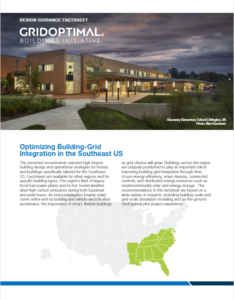With the passing of the Infrastructure Investment and Jobs Act, 2022 will be a big year for energy efficiency, building codes and grid modernization. As we make gains in energy efficiency, and continue to add more intermittent renewables to our power system, grid operators face mounting challenges matching supply with demand. This year is when we must put our attention to getting building-grid interactivity right.

Today, nearly 4% of U.S. electricity comes from solar energy—more than 80 times its share a decade ago, according to the Solar Energy Industry Association. Much of that power has come onto the grid with little or no regard for what’s required of utilities to respond and adapt. Buildings account for 70% of U.S. electricity consumption and are the primary drivers of about 80% of peak demand on the grid.
“Behind the meter” distributed energy resources (DERs) such as rooftop solar, electric vehicle car batteries, and appliances with “smart” controls, can be an asset to grid managers because they enable buildings to shed and shift demand at opportune times (peak demand). Such grid-interactive building measures could save the U.S. power system between $100 to 200 billion over the next 20 years, according to the U.S. Department of Energy (DOE). In addition, the measures would cut CO2 emissions by 80 million tons per year by 2030, the equivalent of shutting down 20 coal-fired power plants.
Yet how to integrate DERs into the grid and compensate their owners and operators for the values they provide is an ongoing challenge. The good news is, we’re seeing more investment than ever before in solving this problem, with 2022 being a bellwether year for grid-enabled efficient buildings and their essential role in transitioning to a 100% carbon-free grid. In fact, cumulative DER investment in the U.S. between 2020 and 2025 is forecasted to surpass $110 billion, with DER capacity reaching 387 gigawatts, according to a new Wood Mackenzie report. For comparison, that’s more than 70% greater than the total installed wind and solar capacity in the U.S.
Latest GridOptimal tools provide answers to key questions
Over the last four decades, utilities and governments have successfully launched programs to reduce energy load through building energy efficiency measures, measured in kilowatt hours or therms saved. Many programs also incentivize building demand savings, measured in peak kilowatts. The metrics for measuring grid optimization are much more nuanced, however, and vary region by region and building type by building type. Plus, many utilities have additional priorities, including low/moderate income customer benefits and greenhouse gas (GHG) emissions savings.
The GridOptimal® Buildings Initiative, launched in 2018 by New Buildings Institute (NBI) in partnership with the U.S. Green Building Council (USGBC), set out to develop standards, tools and guidance focused on helping organizations prioritize grid optimization measures that have the highest potential to help them meet their goals. The initiative has been funded by utility partners and includes a collaborative of utilities, designers, government, consultants, researchers, advocates, and academia.
GridOptimal buildings design and operations fact sheets
Over the last six months, GridOptimal has released a series of tools to help changemakers on both sides of the meter improve building-grid interaction through design, operations, and better integration between energy efficiency and demand response programs. These include:
- Advice targeted to the grid mix in a particular region. A series of 13 four-page fact sheets offer regional and building-type oriented context and recommendations for high-impact building design and operations strategies to improve grid optimization. Each fact sheet is customized for one of six commercial and residential building types or one of seven U.S. climate/grid regions. Designers, owners, and other industry decision makers can reference these fact sheets to make sure they are including the right high-impact grid optimization strategies in their building projects.
- Guidance for utilities on best practice grid-interactive programs. Released this month, GridOptimal published a GridOptimal Utility Programs guidance memo for utility program designers and implementers, providing in-depth and straightforward guidance around how to launch pioneer grid-interactive building utility programs. The memo helps utilities determine which measures to prioritize—ranging from equipment replacement and upgrades to energy storage—and how to measure impacts. This is helpful for utilities seeking to tune up their existing energy efficiency and demand response programs as well as to utilities looking to pilot new, innovative program structures.
- Interactive planning tool that compares impact of measures. The GridOptimal Measure Impact Analysis Tool summarizes the key findings of the GridOptimal Buildings Initiative in a free, interactive online planning tool that allows utility program planners and implementers to easily compare measures (e.g. high efficiency lighting, building envelope) across many dimensions (e.g. climate zone, grid region, building type).
Attention to building-grid optimization catalyzes momentum
 The GridOptimal LEED pilot credit known as the GridOptimal Buildings Pilot Alternative Compliance Path (ACP), released in March 2021, empowers designers, architects, and engineers to incorporate grid optimized building measures into new construction. Project teams pursuing LEED v4 or LEED v4.1 can earn three points for building grid optimization measures. We devoted an entire blog post to the LEED pilot when it launched, and almost a year later, project teams from the U.S. and Canada, and as far afield as Japan and Saudi Arabia, have expressed interest. During the pilot phase, designers are invited to participate in a survey that helps the developers of the credit to learn in real-time how it’s being used, and to make improvements. We expect to see more growth in 2022 as project teams incorporate these credits into their planning and pipelines.
The GridOptimal LEED pilot credit known as the GridOptimal Buildings Pilot Alternative Compliance Path (ACP), released in March 2021, empowers designers, architects, and engineers to incorporate grid optimized building measures into new construction. Project teams pursuing LEED v4 or LEED v4.1 can earn three points for building grid optimization measures. We devoted an entire blog post to the LEED pilot when it launched, and almost a year later, project teams from the U.S. and Canada, and as far afield as Japan and Saudi Arabia, have expressed interest. During the pilot phase, designers are invited to participate in a survey that helps the developers of the credit to learn in real-time how it’s being used, and to make improvements. We expect to see more growth in 2022 as project teams incorporate these credits into their planning and pipelines.
On the policy side, the 2024 IECC development process could ensure key actions that enable grid-enabled efficient buildings make it into our model code. NBI submitted six grid-related code proposals to the IECC including new compliance credits for improved demand flexibility (section C406) as well as control requirements for equipment such as heat pump water heaters (which is already required in the states of California, Oregon and Washington).
Meanwhile, DOE has funded nearly $100 million dollars in field validations and other projects that will demonstrate how energy efficient, grid-interactive technologies can transform homes and workplaces into connected communities. One pilot project led by Austin Energy in partnership with NBI and selected technology vendors will test how certain technologies can improve the resilience of multifamily buildings while also shifting their energy loads to enhance their demand flexibility.
Under the “Advanced Grid Responsive Technologies for Existing Multifamily Properties” project, the research team will install and evaluate the performance of market-ready, easily addressable mesh networks of thermostats, HVAC systems, and water heater controls with two-way communication and remote-access capabilities in six to seven multifamily properties. By focusing on affordable multifamily housing, this project will seek to demonstrate a scalable pathway to bringing the benefits of better building-grid optimization to community members that have often been left out of the benefits from advancing technology deployments: an important equity outcome The project will impact 1,400 tenant units, over half of which are affordable rent or low-income properties. If these technologies work as planned, residents could save $60 to $120 per year on their energy bills while delivering grid services to the utility and cost savings to the building owners: a triple-win.
Looking ahead: Building-grid optimization is more critical than ever
As NBI’s focus on the GridOptimal Building Initiative shifts from research to implementation, we will continue this important work in a variety of ways including technology field validations, code and policy advancement, industry guidance and direct support to achieve the market changes we seek. We look forward to continued work with forward-looking utilities, designers, engineers, jurisdictions, and others to ensure buildings become an even more valuable asset to the grid as we transition toward a clean, reliable, affordable, equitable, and sustainable energy economy.
For more information about GridOptimal and NBI services on building-grid interactivity, please contact Alexi Miller at [email protected].
By Alexi Miller, Associate Technical Director

Bio
Did you enjoy this content? Consider supporting NBI’s work with a donation today.
